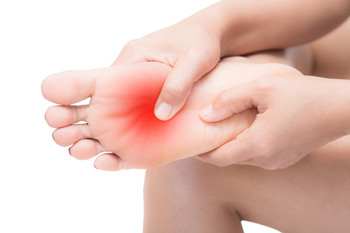 The cuboid is a cube-shaped bone located in the middle of the foot. Since this bone is in an area that is not directly involved in bearing weight, an injury to the cuboid bone is not common. Nevertheless, it is still wise to be on the lookout for any signs of injury to the cuboid bone. Cuboid syndrome occurs when the cuboid bone is knocked out of its proper alignment, typically due to another injury, such as an ankle sprain, or from repetitive stress being placed on the bone. Symptoms of this condition include foot pain, bruising, swelling, and a reduced range of motion in the foot. Cuboid syndrome can be diagnosed through physical examination and treatments are typically conservative. If you are experiencing the symptoms of cuboid syndrome, it is recommended that you seek the care of a podiatrist.
The cuboid is a cube-shaped bone located in the middle of the foot. Since this bone is in an area that is not directly involved in bearing weight, an injury to the cuboid bone is not common. Nevertheless, it is still wise to be on the lookout for any signs of injury to the cuboid bone. Cuboid syndrome occurs when the cuboid bone is knocked out of its proper alignment, typically due to another injury, such as an ankle sprain, or from repetitive stress being placed on the bone. Symptoms of this condition include foot pain, bruising, swelling, and a reduced range of motion in the foot. Cuboid syndrome can be diagnosed through physical examination and treatments are typically conservative. If you are experiencing the symptoms of cuboid syndrome, it is recommended that you seek the care of a podiatrist.
Cuboid syndrome, also known as cuboid subluxation, occurs when the joints and ligaments near the cuboid bone in the foot become torn. If you have cuboid syndrome, consult with Bruce Smit, DPM from Frankfort Foot & Ankle Clinic. Our doctor will assess your condition and provide you with quality foot and ankle treatment.
Cuboid syndrome is a common cause of lateral foot pain, which is pain on the outside of the foot. The condition may happen suddenly due to an ankle sprain, or it may develop slowly overtime from repetitive tension through the bone and surrounding structures.
Causes
The most common causes of cuboid syndrome include:
Symptoms
A common symptom of cuboid syndrome is pain along the outside of the foot which can be felt in the ankle and toes. This pain may create walking difficulties and may cause those with the condition to walk with a limp.
Diagnosis
Diagnosis of cuboid syndrome is often difficult, and it is often misdiagnosed. X-rays, MRIs and CT scans often fail to properly show the cuboid subluxation. Although there isn’t a specific test used to diagnose cuboid syndrome, your podiatrist will usually check if pain is felt while pressing firmly on the cuboid bone of your foot.
Treatment
Just as the range of causes varies widely, so do treatments. Some more common treatments are ice therapy, rest, exercise, taping, and orthotics.
If you have any questions, please feel free to contact our office located in Frankfort, IL . We offer the newest diagnostic and treatment technologies for all your foot care needs.